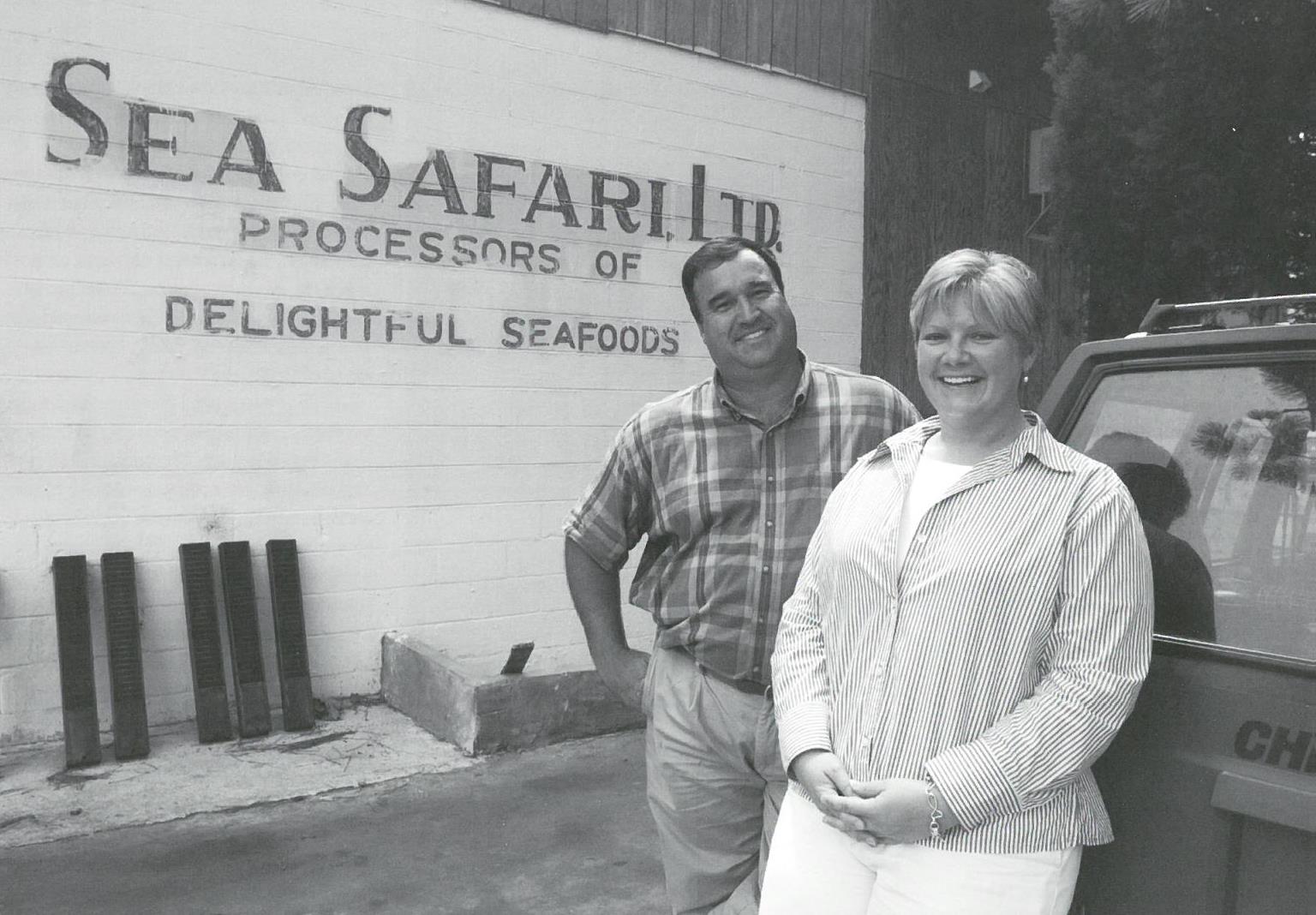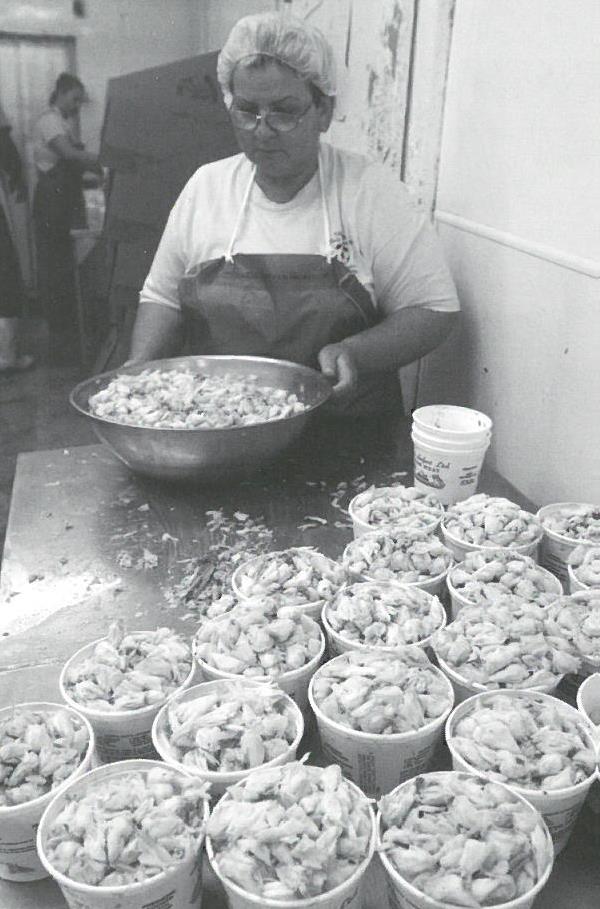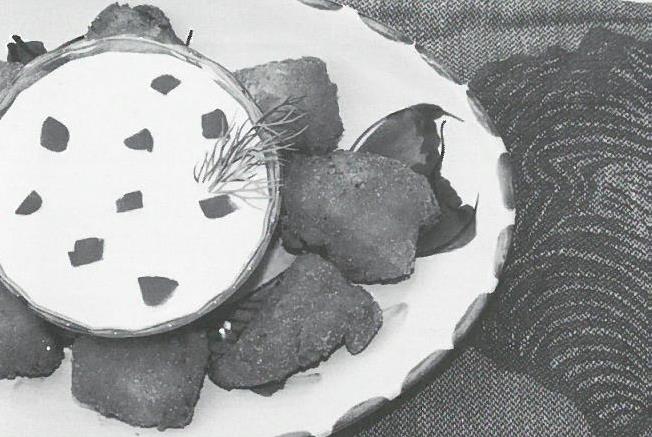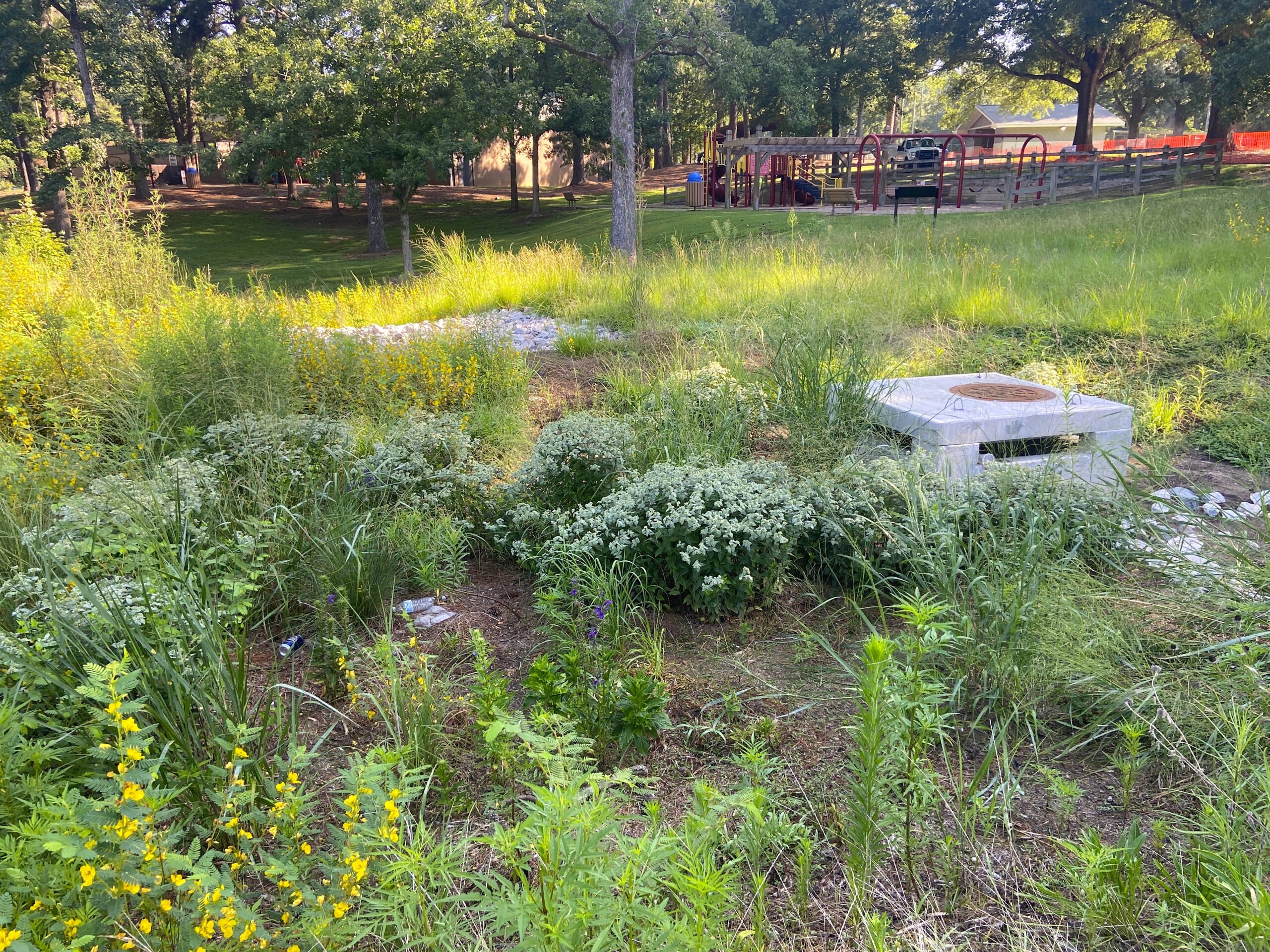North Carolina Seafood Processors Go Global

In the crab-picking room at Sea Safari, Ltd. in Belhaven, women in waterproof boots, aprons and caps of many colors crowd around tables mounded high with cooked blue crabs. Beneath the audible chaos of many competing conversations is the visual rhythm of hands precisely disassembling crustaceans into handpicked, “gourmet” crabmeat.
The scene is its own contradiction. It is similar to crab-picking houses of the past, but the similarity merely accentuates the degree to which things have changed, and are changing. Local women who learned crab picking at their mothers’ knees are rare. Conversations around the picking tables are in Spanish.
The picking house is only one in a maze of nondescript buildings collectively called Sea Safari on the Pungo River near the Pamlico Sound. The first clue that this is not an ordinary seafood processing plant is finding yourself eyeball-to-eyeball with a gigantic buffalo head mounted on the wall in a second-floor office area.
Sea Safari’s owner, Topper Bateman, is an avid hunter, says Sarah Harris, the company’s director of research and development. The buffalo was bagged by Bateman’s wife on a hunting expedition.
While the buffalo on the wall has nothing to do with seafood, it may have, subliminally at least, influenced the name of one of Sea Safari’s newest products — the Buffalo Catfish Nugget, a very lightly battered, deep-fried piece of succulent North Carolina aquacultured catfish.
The nugget is one of Harris’ favorites from the company’s line of “value-added” products and represents the expedition that Sea Safari is taking into the brave new world of global marketing.

Value-added foods are processed to be different in form, taste and texture from the principal raw ingredients. Barry Nash of North Carolina Sea Grant and the North Carolina State University Seafood Lab says that “value,” in this context, means “using processing techniques, novel ingredients or packaging to enhance the health attributes, the sensory characteristics or the convenience of food.”
Traditionally, Sea Safari’s product list consisted of seafood products to be used as ingredients themselves, such as frozen crabmeat in a variety of forms — from jumbo lump to “cocktail fingers.”
The value-added products began as a project funded by the North Carolina Fishery Resource Grant Program. Bateman applied for a grant from the program and put Harris in charge of developing the new items.
“The seafood industry has to diversify beyond commodities to compete in the global seafood market,” Harris says, noting that many of the state’s crab processing plants have gone out of business in recent years due, in part, to competition from imported crabmeat.
Product development is too costly and time-consuming for many small businesses. Yet, without this type of diversification, crab processing plants are likely to continue in a downward spiral.
The FRG project paired Harris with Nash to create a new line of crabmeat-based, value-added products.
FRG was custom-designed for this scenario. Funded by the N.C. General Assembly and administered by North Carolina Sea Grant, the program helps people in fishing and seafood industries to develop ideas for improving their businesses or the resources they depend upon.
Nash points to the success of Wanchese Fish Company in developing the “scallop medallion” in a previous FRG project that used enzymatic cold-binding to create large scallops from smaller, less profitable ones.
“The Sea Safari FRG was designed to show how textured vegetable proteins could add value to processed or cooked seafood,” Nash explains. He and Harris proposed creating four new products: shrimp and crab appetizers, an inexpensive crab cake to target an economy market, and a higher priced crab cake to appeal to more affluent customers who shop online.
Results Exceeded Expectations
Call it overachievement: The four products Harris and Nash set out to create ended up increasing the company’s list of value-added seafoods from four to 22.
The success of the project, however, is more than numbers of products developed. Information that will be in the final report from the project can help other seafood processors, because, like it or not, global seafood competition has arrived in North Carolina.
On the Way To a Global Market
The crabmeat trade in North Carolina is older, probably, than the establishment of the state.
“It goes back to John White and the Lost Colony on Roanoke Island,” says David Green, director of N.C. State’s Center for Marine Sciences and Technology in Morehead City. Only then, crabs were a literal trade — between the settlers and native Americans.
Over time, the blue crab industry grew into the state’s most lucrative fishery. Then things started to change.
The shift in repartee around the crab-picking tables from “down east” brogue to Spanish was one sign. Local labor had gone elsewhere for dependable, year-round, more pleasant work. Meanwhile, catches of local blue crabs dwindled, and the crab season shortened. At the same time, an influx of less expensive, imported crabmeat was nudging out domestic market share.
Lingering effects from a series of hurricanes in 1996 and 1997 altered estuarine habitats, and the crab supply declined further.
The already struggling industry began to plummet. “We had an accelerated shift from domestic to imported products,” Green explains. “We no longer can be commodity-based because we can’t compete at the commodity level.”
Although the changes were swift, they did not take processors by surprise, says Green.
“They actually saw it coming, but there was little they could do to counteract it,” he says, citing a shift in supply from Asia and Indonesia to U.S. markets.
Jimmy Johnson, who works in sales at Sea Safari, bears witness to the changes in crab processing in recent years.
The sudden intrusion of a global market on the eastern shore of North Carolina translated into painful reality as many local processors, including Johnson, were unable to compete. The dream of Johnson and his wife, Donna, of owning her family’s processing plant had become a reality in 1996.
“For a couple of years, it was a pretty good dream. Then it became a nightmare,” says Johnson. “It got to the point where you could not produce crabmeat for any kind of profit.”
“We had to sell the business or lose everything we’d worked our whole lives for,” he says. Other processors also felt pressure.
Doug Cross of Pamlico Packing Company in Vandemere puts it like this: “Between government regulations and increased competition from various imports, the industry is changing. And it’s not slowly but surely — it’s happening pretty quick.”
Nash is helping Cross with an FRG project to develop a line of seafood dips and salads with a six-week refrigerated shelf life for Pamlico Packing. They have 16 products now and plan to select the top eight before testing preservation systems devised through the FRG project.
Cross agrees that value-added products are important.
“It’s another slice of the pie, I guess. But the pie is getting so thin now-a-days, you better have a lot of slices.”
Nash compares the old style of crab processing to farming — offering a harvested product to a competitive market and hoping for the best. To survive, he says, “processors must transition from commodity-based to market-driven businesses.”
That translates into what consumers demand.
Cooking Up What Consumers Want
“People want to eat seafood. There just aren’t enough attractive value-added items to satisfy consumers’ needs,” says Nash.
In particular, he says, they want food that is “healthful, flavorful and easy to prepare.”
And Green notes that freshness counts. When consumers know the origin of crabmeat, he says, they prefer to buy local as long as prices are nearly equal.
Green adds that sensory evaluations at the seafood lab show consumers prefer the taste of blue crab over imported species. Without side-by-side comparisons, however, many consumers may lack that culinary sensitivity.
“Younger people coming in have grown accustomed to imports because they have never tasted the difference,” Green says.
In addition to taste, there’s convenience.
“The U.S. is geared to time-saving,” says Green. “Seafood lends itself to that market because it’s quick to prepare.” Further preparation makes it even more convenient, he says.
Nash says ease to consumers means either “cooked ready-to-eat or heat-and-serve.”

He notes that “the value of the packaged-foods market is estimated to be in the billions of dollars.”
Convenience is paramount to Americans, who spend $118 billion annually on fast food, according to an article by New York Times food columnist Jane E. Brody. That statistic should be heartening to Sea Safari.
An oven-baked seafood patty developed by Harris and Nash is being eyed by a national fast-food chain. Nash says that “being oven-baked was what was appealing about it. “The chain had wanted a seafood product that was baked instead of deep-fried — one that could meet their expectations for quality and convenience.
Most of Sea Safari’s new products are frozen, bake-and-serve items that make a complete meal or entree. They are being offered in some grocery stores.
The value-added line resulted from the synergy of the Harris-Nash team. Nash has more than 17 years of food-industry experience specializing in ingredient technology and product development. Harris says this and Nash’s industry contacts have been invaluable.
Harris brings a background in chemistry and food safety management to the mix. The precision of a chemist is a good fit for food product development.
“Even when you’re in your kitchen using a recipe, you’re using chemistry,” she says. And while it’s useful knowing how to use chemicals in food processing when necessary, she says that Sea Safari tries to avoid preservatives.
But one reason the Harris-Nash duo is dynamic is that they represent the two things consumers seem to want the most from food — good flavor and convenience.
Nash likes good food, he says, but he would rather be outside hiking or kayaking than inside cooking or cleaning afterward. Convenience is for him.
Harris is a natural cook with long family ties to the coast and to seafood. “I’ve always enjoyed cooking,” she says. “My mom is a really good cook.”
Growing up in the coastal South had its own culinary advantages — like picking crabmeat out of stewed hard crabs at the tender age of five or six. It was a family thing.
“My granddaddy had a CB radio, and his handle was “Goose Creek Crab Eater,” she says. “Who would have guessed that 20 years later, I’d be working in a crab facility.”
To Harris, developing a new seafood product is like “working backward.”
“You have to do a lot of research in the market to see what price point you have to hit. It’s difficult to start with the price,” she says, citing factors such as profit, labor, ingredients, freight and storage.
Sea Safari aims for mid-range in price, she explains. Not the most expensive, but not the least, either.
Her coastal roots have grown into her role as a seafood product developer. For the breaded items, like the catfish nuggets, Harris says the “breading” is a dusting of seasoned flour that allows the taste of the real food to come through and gives a pleasing appearance.
“The biggest problem to overcome with developing seafood products is having to realize it’s not your own taste you have to please. You’re trying to feed the masses. You have to know the target audience and make a formula to fit,” she says.
The company should be able to hit almost any target with the variety of seafood products it now boasts. To its original value-added calamari and clam crisps, it now has a tantalizing assortment of seafood items. Crab, Corn and Jalapeno Popums, Crab Stuffed Fish Rolls and Shrimp Paella are just a few.
The acquisition of Ecrevisse Acadienne, USA in 1996 gave the company a product not usually associated with North Carolina — crawfish. With the FRG funding, Sea Safari has added Cajun Crawfish and Chicken Jambalaya, Crawfish Etouffee and Crawfish Creole to the repertoire. It’s global marketing with an ethnic flair.
Nash says product development can take a year to 18 months. It means devising a product concept with the expertise, equipment and packaging required, plus microbial testing, shelf-life testing, analyses for nutritional labeling and sensory evaluation.
Sea Change For the Crab Industry
“Our company is an example of where the industry is headed in the state if they’re going to stay in business,” Harris says. “It’s important to develop partnerships with other seafood businesses.”
One such partnership is between Sea Safari and Carolina Classics of Ayden to make the Buffalo Catfish Nuggets. “Carolina Classics supplies the catfish, and Sea Safari does the rest of the processing,” Harris says. Both companies get a value-added product to sell under their own names in the bargain.

Green says that crabbers benefit from a healthy processing industry as well.
“There is a symbiotic relationship between crabbers and the crab-processing house,” he says. “If the volume (of crabs) is high, the only way to sell is to the processing house. If many go out of business, the market is limited — last year both suffered because of lack of supply.”
A shortage of processors restricts crabbers to a “live basket” trade, Green explains.
Some crab houses want to stay small to keep overhead low, supplying domestic crabs to a pricier niche market. But, Green says, “A big market depends on volume.”
“Going to value-added, even with imports, can allow crab houses to stay in business and stabilize the workforce,” Green says. “Processors need to manipulate supply, regardless of the source.”
Green says Sea Safari is in the forefront with value-added items. “If one company has success, more will try it. Sea Safari is providing leadership and change for the industry,” he says.
Harris emphasizes that Nash and the FRG program have helped tremendously with developing new products and can help other companies as well. The grant paid for an industrial breader and deep fryer that will stay with the seafood lab in Morehead for the use of other processors.
“You don’t always know what equipment you’re going to need,” says Harris. By using equipment from the seafood lab, “you can get a better idea of what you’ll need without the capital investment.”
Harris encourages other seafood processors to take advantage of the resources at the seafood lab and the FRG program.
“The FRG program does work,”she says. “It is there, it is available, and people need to take advantage of it.”
For more information about the FRG program, go online to www.ncsu.edu/seagrant and follow research links, or call 919-515-2454 or 252-222-6312.
This article was published in the Autumn 2002 issue of Coastwatch.
For contact information and reprint requests, visit ncseagrant.ncsu.edu/coastwatch/contact/.
- Categories:


